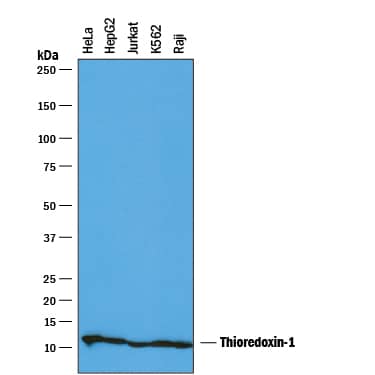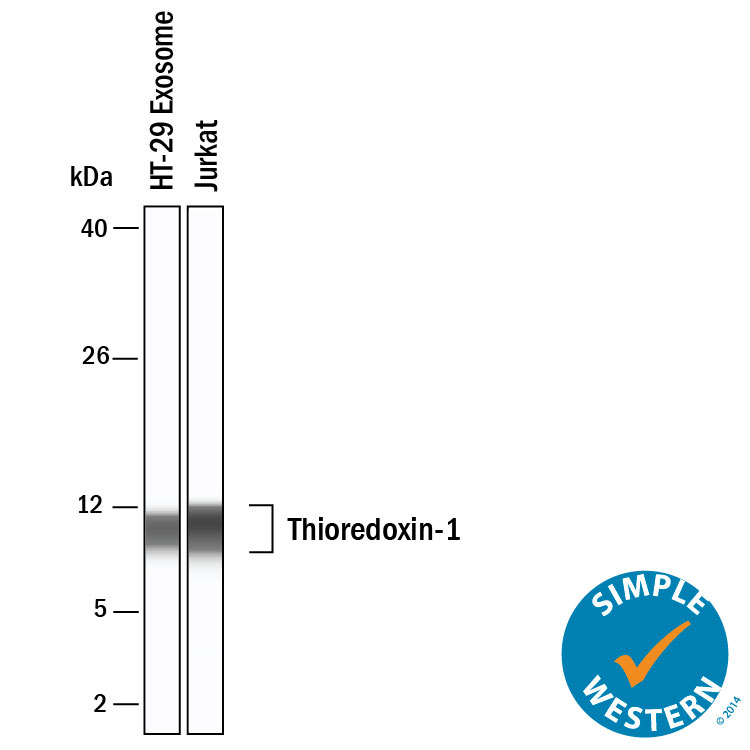Human Thioredoxin-1 Antibody
R&D Systems, part of Bio-Techne | Catalog # AF1970


Key Product Details
Species Reactivity
Validated:
Human
Cited:
Human, Mouse
Applications
Validated:
Immunohistochemistry, Simple Western, Western Blot
Cited:
Immunoprecipitation, Western Blot
Label
Unconjugated
Antibody Source
Polyclonal Goat IgG
Product Specifications
Immunogen
E. coli-derived recombinant human Thioredoxin-1
Val2-Val105
Accession # P10599
Val2-Val105
Accession # P10599
Specificity
Detects human Thioredoxin-1 in direct ELISAs and Western blots. In direct ELISAs, less than 25% cross-reactivity with recombinant mouse Thioredoxin-1 is observed.
Clonality
Polyclonal
Host
Goat
Isotype
IgG
Scientific Data Images for Human Thioredoxin-1 Antibody
Detection of Human Thioredoxin‑1 by Western Blot.
Western blot shows lysates of HeLa human cervical epithelial carcinoma cell line, HepG2 human hepatocellular carcinoma cell line, Jurkat human acute T cell leukemia cell line, K562 human chronic myelogenous leukemia cell line, and Raji human Burkitt's lymphoma cell line. PVDF membrane was probed with 0.1 µg/mL of Goat Anti-Human Thioredoxin-1 Antigen Affinity-purified Polyclonal Antibody (Catalog # AF1970) followed by HRP-conjugated Anti-Goat IgG Secondary Antibody (Catalog # HAF019). A specific band was detected for Thioredoxin-1 at approximately 12 kDa (as indicated). This experiment was conducted under reducing conditions and using Immunoblot Buffer Group 1.Detection of Human Thioredoxin-1 by Simple WesternTM.
Simple Western shows lysates of Exosome Standards (HT-29) (NBP3-11685) and Jurkat human acute T cell leukemia cell line, loaded at 0.5 mg/ml. A specific band was detected for Thioredoxin-1 at approximately 10 kDa (as indicated) using 10 µg/mL of Goat Anti-Human Thioredoxin-1 Antigen Affinity-purified Polyclonal Antibody (Catalog # AF1970). This experiment was conducted under reducing conditions and using the 2-40kDa separation system.Thioredoxin‑1 in Human Breast Cancer Tissue.
Thioredoxin-1 was detected in immersion fixed paraffin-embedded sections of human breast cancer tissue using Goat Anti-Human Thioredoxin-1 Antigen Affinity-purified Polyclonal Antibody (Catalog # AF1970) at 15 µg/mL overnight at 4 °C. Tissue was stained using the Anti-Goat HRP-DAB Cell & Tissue Staining Kit (brown; Catalog # CTS008) and counterstained with hematoxylin (blue). View our protocol for Chromogenic IHC Staining of Paraffin-embedded Tissue Sections.Applications for Human Thioredoxin-1 Antibody
Application
Recommended Usage
Immunohistochemistry
5-15 µg/mL
Sample: Immersion fixed paraffin-embedded sections of human breast cancer tissue
Sample: Immersion fixed paraffin-embedded sections of human breast cancer tissue
Simple Western
10 µg/mL
Sample: Exosome Standards (HT-29) (Catalog # NBP3-11685) and Jurkat human acute T cell leukemia cell line
Sample: Exosome Standards (HT-29) (Catalog # NBP3-11685) and Jurkat human acute T cell leukemia cell line
Western Blot
0.1 µg/mL
Sample: HeLa human cervical epithelial carcinoma cell line, HepG2 human hepatocellular carcinoma cell line, and Raji human Burkitt's lymphoma cell line, Jurkat human acute T cell leukemia cell line, K562 human chronic myelogenous leukemia cell line, and Raji human Burkitt's lymphoma cell line
Sample: HeLa human cervical epithelial carcinoma cell line, HepG2 human hepatocellular carcinoma cell line, and Raji human Burkitt's lymphoma cell line, Jurkat human acute T cell leukemia cell line, K562 human chronic myelogenous leukemia cell line, and Raji human Burkitt's lymphoma cell line
Formulation, Preparation, and Storage
Purification
Antigen Affinity-purified
Reconstitution
Reconstitute at 0.2 mg/mL in sterile PBS. For liquid material, refer to CoA for concentration.
Formulation
Lyophilized from a 0.2 μm filtered solution in PBS with Trehalose. See Certificate of Analysis for details.
*Small pack size (-SP) is supplied either lyophilized or as a 0.2 µm filtered solution in PBS.
*Small pack size (-SP) is supplied either lyophilized or as a 0.2 µm filtered solution in PBS.
Shipping
Lyophilized product is shipped at ambient temperature. Liquid small pack size (-SP) is shipped with polar packs. Upon receipt, store immediately at the temperature recommended below.
Stability & Storage
Use a manual defrost freezer and avoid repeated freeze-thaw cycles.
- 12 months from date of receipt, -20 to -70 °C as supplied.
- 1 month, 2 to 8 °C under sterile conditions after reconstitution.
- 6 months, -20 to -70 °C under sterile conditions after reconstitution.
Background: Thioredoxin-1
References
- Holmgren, A. (1985) Annu. Rev. Biochem. 54:237.
- Powis, G. and W.R. Monfort (2001) Annu. Rev. Pharm. Toxicol. 41:269.
- Deiss, L.P. and A. Kimchi (1991) Science 252:117.
- Spyrou, G. et al. (1997) J. Biol. Chem. 272:2936.
- Miranda-Vizuete, A. et al. (1998) Biochem. Biophys. Res. Commun. 243:284.
- Nakamura, H. et al. (1997) Annu. Rev. Immunol. 15:147.
- Mourice, M.M. et al. (1999) Arthritis Rheum. 42:2430.
- Jikimoto, T. et al. (2001) Mol. Immunol. 38:765.
Alternate Names
Thioredoxin1, Trx1, TXN, TXN1
Entrez Gene IDs
7295 (Human)
Gene Symbol
TXN
UniProt
Additional Thioredoxin-1 Products
Product Documents for Human Thioredoxin-1 Antibody
Product Specific Notices for Human Thioredoxin-1 Antibody
For research use only
